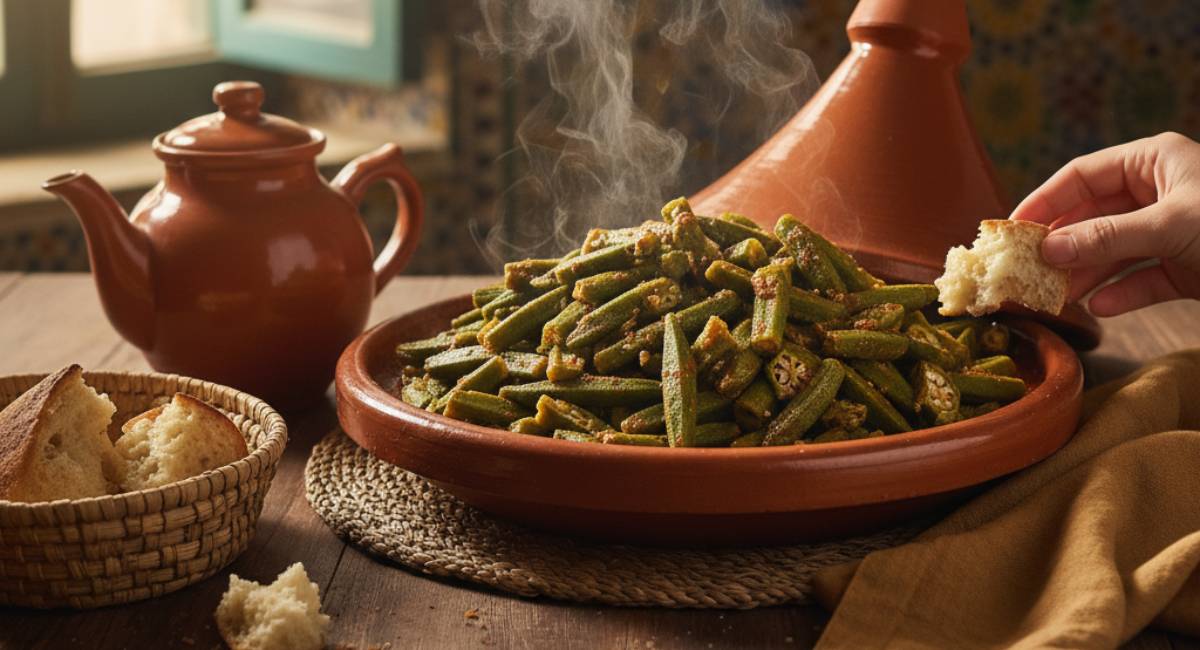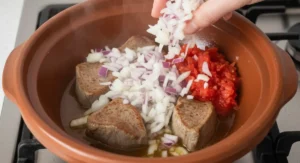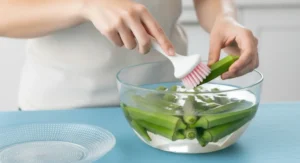
Table of Contents
🟠 A Taste I Once Refused: Childhood Memories of Okra
This slow-cooked Moroccan okra recipe wasn’t always my favorite — in fact, as a child, I avoided it with everything I had.I’ll be honest with you.
There were a few foods I disliked as a child, but okra was at the top of that list. The smell alone was enough. The texture? No, thank you. I didn’t want to look at it, much less eat it.
And every time my mother made her okra tagine, she already knew. She would sigh, smile quietly, and prepare a second dish — just for me. Usually something I saw every week:
- Potatoes with carrots
- Green peppers cooked in tomato
- Familiar vegetables, nothing seasonal
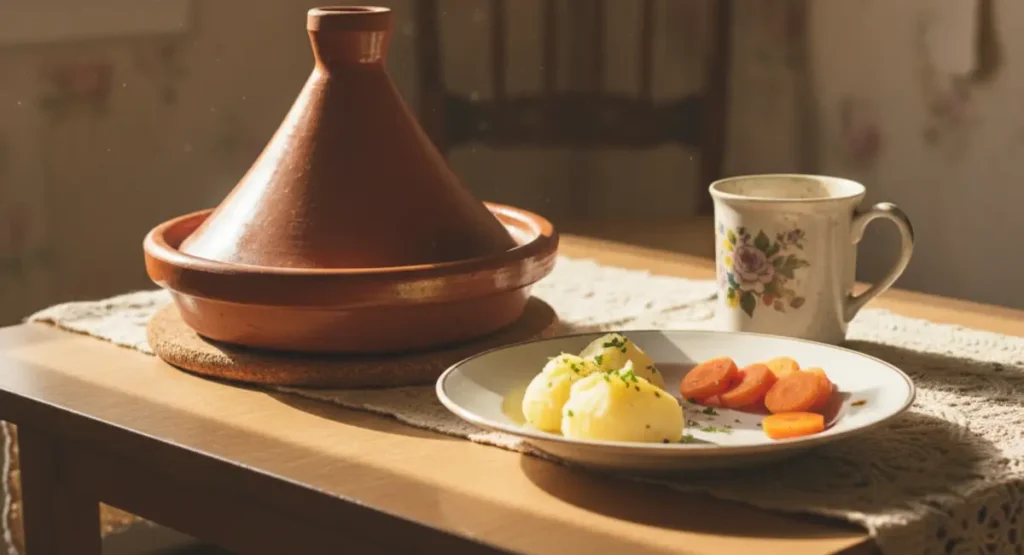
Okra was different.
It didn’t live in the fridge like onions do all year long. It arrived suddenly in the markets, fresh and green, usually in late summer. And then just as quickly — it disappeared.
As a child, I didn’t understand that.
Why eat something that vanishes again right after you accept it?
No — we hold onto familiar foods.
Safe ones. Daily vegetables.
Not visitors like okra.
But my mother never forced me to eat it.
She said:
One day, you’ll ask me to make it.
I didn’t believe her.
I would sit at the table with my plate of potatoes while the rest of the family dunked bread into that dark green sauce.
The table smelled like garlic and tomatoes, spiced lamb, and slow heat…
But my nose turned away. I had made up my mind.
Taste is a mystery. Sometimes it has to wait for the right moment.
🟠 From Guest to Favorite: My Rediscovery of Okra
Moroccan spices can do things your taste buds never saw coming.
It happened at a friend’s house.
No warning. Just a plate… steaming, red, rich. A tagine is already open.
The smell hit first:
- Tomatoes cooking down
- Garlic melting
- Cinnamon dancing beneath cumin and lamb
I didn’t know what was inside. And I didn’t ask.
I took a bite.
Tender lamb. Tangy sauce. Soft okra.
Then silence.
Wait… this was okra?
That day changed everything.
Not just the flavor — but the feeling.
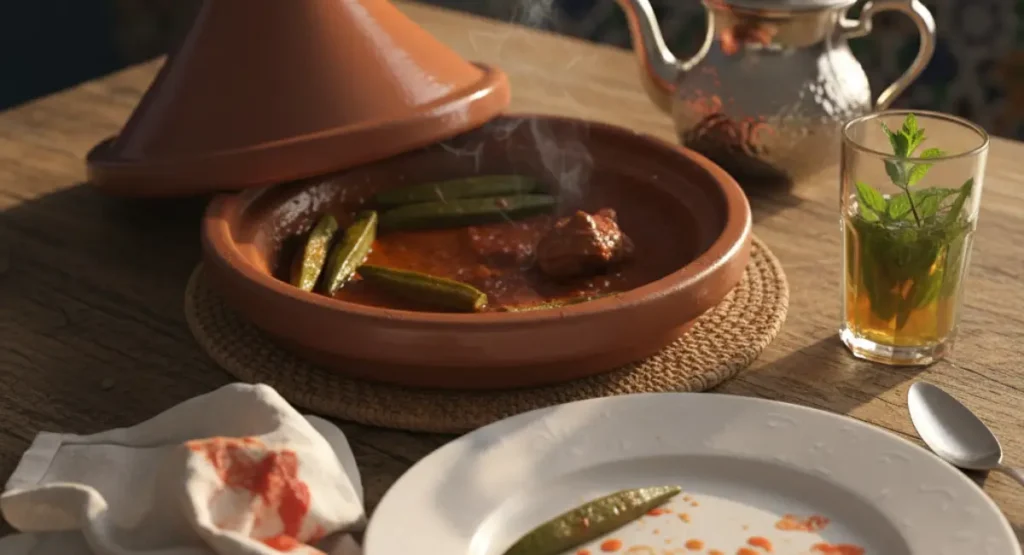
I remembered my mother’s voice. I remembered her hands making the same thing. I remembered saying “no” for years.
So I went home.
And — like the prodigal son of a spice market — I asked:
Why don’t you make your okra tagine anymore, Mama?
She looked up. Smiled like she had waited for this moment.
Right away, my son. This time, I’ll add an extra scoop.
I laughed.
Make it two!
We didn’t just eat that day.
We shared something that had been missing.
🧾 What changed my mind?
The okra was fresh — not slimy, not stringy—just tender.
The lamb had simmered under a roof of Moroccan spice.
The sauce? Tomatoes, garlic, olive oil… cooked into silk.
And maybe… I was just ready.
In Morocco, taste isn’t about age. It’s about readiness. The dish speaks when you’re supposed to hear it.
🟠 Why This Is the Best Okra Recipe I’ve Tasted
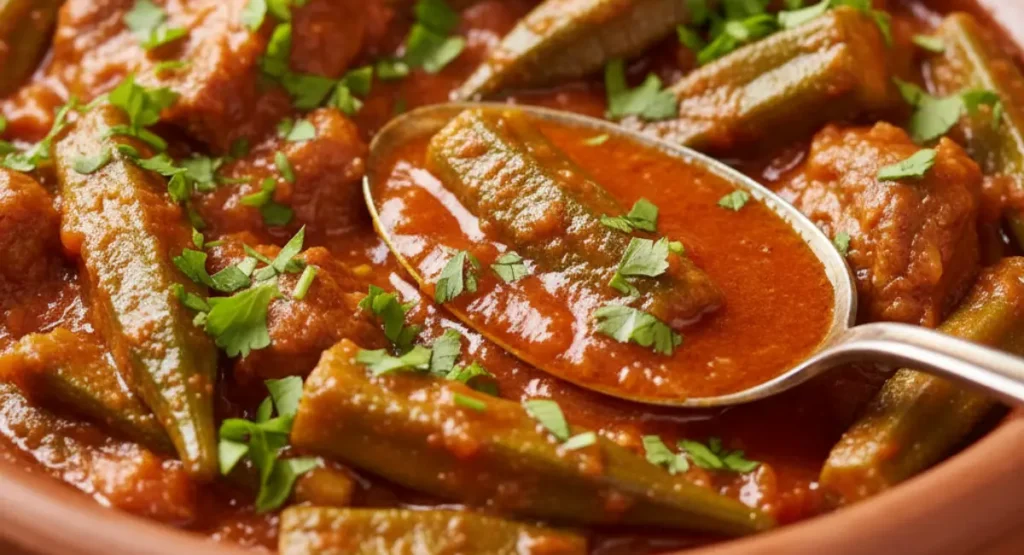
Some dishes get better with time.
Not just when they sit on the stove — but when you grow into them.
This okra tagine is one of those dishes.
I used to run from it. Now I crave it.
Not just the taste — the feeling it leaves behind.
For years, I avoided okra.
I didn’t understand it. The texture. The look. The idea of green pods sliding into sauce.
But the truth is: I didn’t know how to see it properly.
And I didn’t know how to cook it the way it was meant to be cooked.
I had to learn that not all okra is created equal.
And more importantly, not all okra is treated with care.
And that’s where this version changed everything.
🟢 What makes it the best okra recipe I’ve known?
Let me break it down — not as a chef, but as someone who watched this dish come alive in his mother’s kitchen:
🌿 1. The balance of softness and strength
In this dish, the okra doesn’t melt into the stew, and it doesn’t want to be crunchy either.
We clean it right, we slice it right, and we season it before it ever touches the pot.
By the time it’s added, the meat is tender, the sauce is rich, and the mloukhia only needs one thing: patience.
That patience gives okra its final texture:
Soft around the edges, gently holding its shape, and soaking up every drop of flavor.
🥩 2. The lamb
I don’t use lamb by accident.
I use lamb because it matches okra’s delicacy with full flavor and richness.
The shoulder cooks slowly, giving fat and bone time to speak their language — deep, perfumed, and unforgettable.
No beef. No chicken.
Just good shoulder lamb, passed down from farms that know how animals should grow.
🍅 3. The sauce that builds itself
There’s no heavy tomato paste here.
No sugar. No bottled flavor.
The sauce comes from:
- One grated tomato
- A finely chopped onion
- 5 garlic cloves, crushed
- A spoonful of tomato paste
All of it simmered until it changed color, perfuming the room.
That’s when you know the dish has begun.
Add turmeric, ginger, paprika — real Moroccan foundations — and let them live in your pot a while before the okra comes in.
🫱 4. The way we treat the okra
We wash with care.
We cut with intention.
We never, ever stir it hard once it’s added.
We just spoon sauce on top. We cover. We let the mloukhia make her way into the dish like she always belonged there.
You don’t just throw okra in.
You place it where it can listen.
That’s the difference.
🟩 Why this recipe stays with me
Because it doesn’t just taste good.
It teaches you something about what patience brings.
It’s not a loud dish.
It isn’t dramatic.
It doesn’t overwhelm the plate.
Instead, it rounds your hunger.
It rests warm in your chest.
And it reminds you that some food was never supposed to impress…
It was only meant to nourish.
This is the best okra recipe I’ve tasted because it doesn’t try to be anything other than what it is:
- Seasonal
- Humble
- Made with hands, not machinery
- Cooked with care, not tricks
- Eaten by tearing bread with fingers, not biting into crisp layers
You want to know if someone knows how to cook okra?
Don’t look at how they serve it.
Look at how they treat it when it goes in the pot.
🟠 Ingredients That Make This Dish So Special
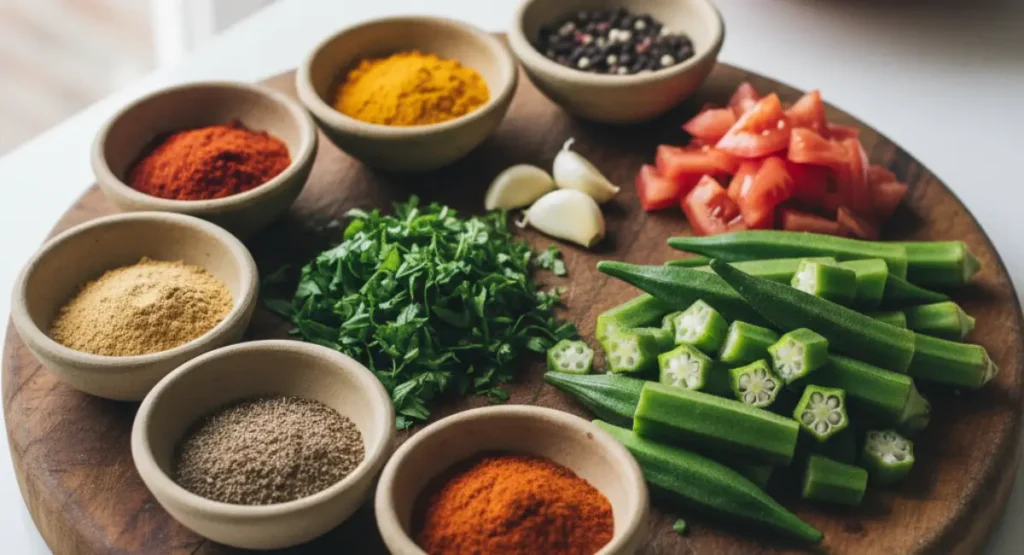
Every dish has a soul.
But in Moroccan cuisine, the soul begins with the ingredients.
The smell of garlic hits oil.
The steam rising from the tomato and onion.
The light scent of fresh mloukhia is waiting its turn.
This tagine doesn’t ask for much — but what it asks, you must do right.
Our grandmothers didn’t have thermometers.
But they had trust in their hands. That was enough.
🟢 For the Lamb Tagine
Here’s what I use — always:
- 1 kg lamb shoulder (“ktef”) — soft, flavorful, with just the right fat
- 1/2 cup oil (olive oil or neutral vegetable oil)
- 1 tomato, grated
- 1 small onion, finely chopped
- 1 tbsp tomato paste
- 5 garlic cloves, crushed
- 1 tsp paprika (sweet)
- 1 tsp turmeric
- 1 tsp ground ginger
- 1/2 tsp black pepper
- 1/2 tsp salt (adjust to taste)
- A handful of parsley, finely chopped
- 1/2 cup hot water (as needed)
These are not suggestions.
This is the foundation — the true base of flavor in this tagine.
🟢 For the Mloukhia (Fresh Okra)
This part needs care — real care.
Here’s how I prepare it, every time:
1. Rinse thoroughly
Wash the okra under plenty of water to remove all dirt.
It’s a seasonal vegetable, and you’ll always find a bit of earth.
2. Scrub gently but firmly
Use a soft brush or clean cloth to wipe each pod.
Don’t rush. This is what gives clean, good flavor.
3. Drain completely
Use a strainer and let them sit for a few minutes.
Then pat them dry with a kitchen towel.
Okra needs to be dry before cutting.
4. Trim and cut
Trim the top stems. Then slice crosswise into small pieces, just like you saw in your mother’s kitchen.
5. Season lightly
Add:
- A pinch of salt
- A small touch of black pepper
Mix with your hands or spoon — let the seasoning kiss every piece.
6. Optional: lemon juice at the end
Add a few drops of lemon juice to the finished tagine before serving.
It helps the stomach and brightens the whole dish.
We don’t prepare mloukhia as a vegetable.
We prepare it like memory — washed, softened, and welcomed.
🟠 How to Cook Okra the Moroccan Way
Some dishes ask for precision.
And some dishes ask for care.
This one — this okra tagine — only works if you respect the rhythm.
Cooking okra the Moroccan way isn’t about technique.
It’s about sequence, flavor, and trust.
You learn it with your nose before you learn it with your hands.
That’s how the women in my family taught me.
Let me walk you step by step, just like I saw it done a hundred times in my mother’s kitchen.
And now, in mine.
🟢 Step-by-Step: How to Cook Okra Like We Do at Home
🔸 1. Get the base just right
In a clay tagine or a heavy-bottomed pot, pour about 1/2 cup of oil — olive oil, or a mix with neutral vegetable oil.
Let it warm gently, not sizzle.
Drop in the lamb pieces — about 1 kg, preferably from the shoulder—no need to sear or brown them.
Just give them a home in the oil and let them slowly come to life.
Immediately, sprinkle salt and add the crushed garlic. Stir gently. Let the lamb catch the perfume.
Next, add:
- 1 finely chopped medium onion
- 1 grated fresh tomato
- A spoonful of concentrated tomato paste
Stir well. Let this mixture cook for several minutes, allowing everything to soften.
This is not about high heat or hurry.
It’s about inviting flavor slowly, the way you let a guest through the door.
Then add the spices:
- 1 tsp ground ginger
- 1 tsp paprika (sweet)
- 1 tsp turmeric
- 1/2 tsp ground black pepper
Stir again. You’ll smell the moment they blend — the spices warming gently into the sauce.
Finally, add about 1/2 cup of hot water, enough for the lamb to begin its long, quiet cooking.
Toss in a handful of chopped fresh parsley. Then cover the pot.
Let it cook on low heat, slowly.
You’re building depth now. This part takes 45–60 minutes, depending on the cut.
Don’t stir too often.
Just lift the lid a few times to check the liquid.
If it dries, add water gradually — always hot. Never cold. That’s a golden rule in Moroccan kitchens.
🟢 Preparing the Okra (Mloukhia)
While the meat cooks, it’s time to prepare the okra.
Take about 500 grams of fresh mloukhia — tender, green, not too long.
Rinse them thoroughly in a large bowl of fresh water.
Don’t be afraid of water.
Mloukhia grows in soil. There’s always dust.
So rinse well. Then use a soft vegetable brush or a clean cloth to scrub each one.
Yes, one by one. That’s how we do it.
Once clean, drain them well.
Let them sit in a colander to dry, or pat them carefully with a towel.
Then, cut off the tips, and slice into pieces — not too fine, not too thick.
Just right for stewing.
Place the cut okra in a bowl and season lightly with:
- A small pinch of salt
- A pinch of ground black pepper
Mix gently. Set aside. They’ll be ready when the meat calls for them.
🟢 Bringing It All Together
When the lamb is properly cooked — tender but not falling apart, and the sauce has reduced into a thick, fragrant base…
It’s time.
Take the seasoned okra and lay it gently over the meat. Do not stir. Just place it like a soft blanket.
Then take a spoon and pour some of the sauce over the okra, little by little.
The okra will absorb the flavor — slowly, silently.
If the sauce is too reduced at this point, add a bit more hot water (just a splash), so the mloukhia can cook without sticking.
Cover the tagine again.
Let the whole dish simmer on the lowest heat for another 20–30 minutes.
You’ll know it’s ready when the okra stops looking like okra…
and starts looking like part of the sauce.
Once the okra is tender and the sauce has thickened just a little more, turn off the heat.
Let the tagine rest for 10 minutes, covered. That’s when everything settles.
And just before serving — if you like — squeeze a few drops of fresh lemon juice across the top.
It’s not mandatory.
But it helps the digestion, as my mother always said.
For mloukhia to love you, feed it gently, season it patiently, and let it rest before it’s seen.
🟠 Okra and Tomatoes: The Soul of Maghrebi Stew
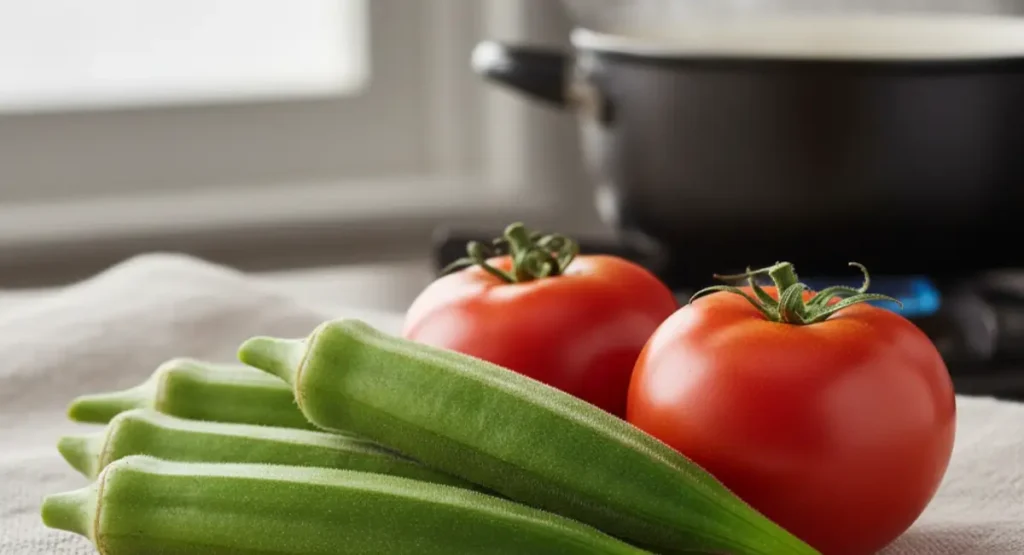
Some ingredients aren’t just added —
They’re meant for each other.
That’s how I feel about okra and tomatoes.
It’s not a combination someone invented.
It’s something that’s always been, in every kitchen I remember.
In Moroccan cooking, we don’t ask ‘what goes well with what.’
We ask: how do ingredients complete each other?
Okra is soft. Gentle. A little starchy inside. It holds itself together — barely.
But slice it raw, and it shows its weakness: a little bitterness, a certain resistance.
Tomatoes, on the other hand, show up bold.
High in acid. Bright in character.
And most importantly, they melt.
When you cook them together, something happens:
The tomato’s sharpness tames the okra’s edge,
and the okra — in return — lends body to the sauce.
Natural balance.
🍅 Why does this dish always start with tomatoes
In every tagine I’ve seen — especially in the north of Morocco —
When someone cooks okra, they always add at least one grated tomato.
Even if they’re in a hurry. Even if the okra is perfect.
Why?
Because the tomato is the architect of this stew.
It gives:
- Rich color
- A gently acidic base
- Natural thickening (without flour, without tricks)
- A faint sweetness once it cooks down
No need to overdo it. One tomato and time will do what five spoons of paste can’t.
🔴 The color says it all
When this dish is ready, look at it.
It’s not green.
Not red.
But somewhere in between — a deep rusty tone, like the earth after the first rain.
That’s okra and tomatoes talking to each other.
No confusion. No competition. Just a conversation in flavor.
If you ask me what makes this stew “Maghrebi” at its core?
It’s not the spices. Not the olive oil. Not even the clay pot.
It’s that moment when the sauce finally pulls together — thick, rich, and round —
And you see how two ingredients can become one voice.
🟠 Serving the Tagine Like We Do at Home

This isn’t just a dish.
This is a moment.
When the tagine is ready, we don’t rush.
We don’t plate it in bowls.
We bring it as it is — hot, still bubbling, straight from the fire to the middle of the table.
The tagine isn’t served.
It arrives. And when it does, everyone leans in.
First, the bread.
Not toast. Not pita.
We’re talking about khobz — round, crusty, homemade Moroccan bread.
It’s not a side.
It’s your spoon.
We break it into small pieces, torn by hand — no knives, no forks.
We use it to scoop up everything:
- The sauce at the bottom — thick and red
- The tender chunks of lamb
- The softened okra, now drenched in flavor
And always, someone gets the honor of the first dip.
Usually the guest. Or the eldest. Or the one who just walked in.
Then, the mint tea.
Hot. Sweet. Poured from high.
It’s not dessert — it’s the closing note.
You sip it slowly, your hands still warm from the tagine.
And that steam carries cinnamon, lamb, tomatoes… everything you just tasted.
We don’t rush after a tagine.
We sit. We sigh. Sometimes, we stay quiet — just to let the flavor linger.
There’s no garnish. No drizzle. No “presentation.”
Just:
- Bread, broken by hand
- Tea, poured into a glass
- A shared dish in the center
- People talking without words
- Smiles after silence
Everything in one pot — the way we’ve done it forever.
🟠 Health Benefits of Okra You Didn’t Expect
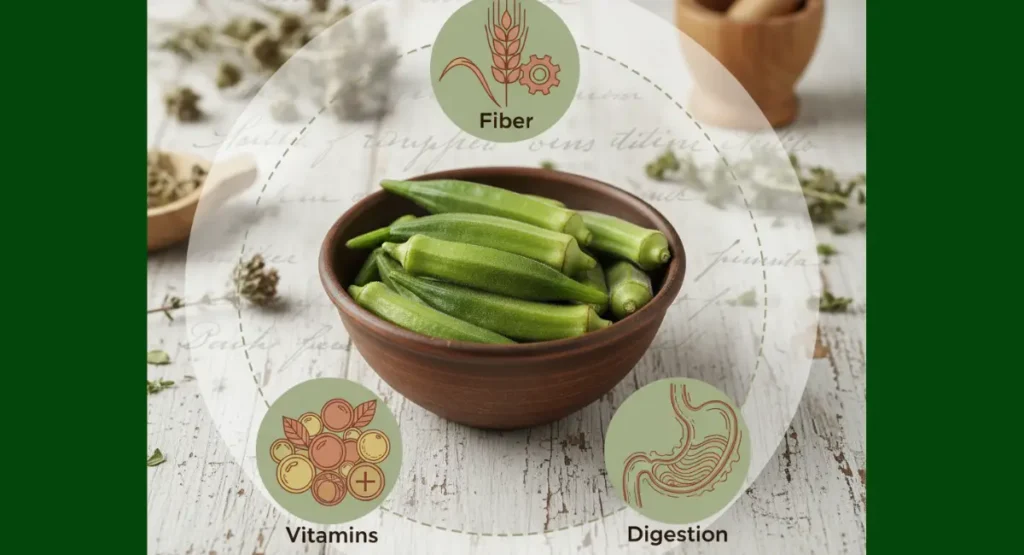
Most people think okra is just… okra.
A green vegetable. A little slimy. Good in stews. But not much else.
They’re wrong.
This plant is a doctor in disguise, especially when cooked slowly, with the right partners — lamb, spices, lemon.
Back home, we didn’t say ‘this is healthy.’
We said: ‘Eat this. It will make you feel better.’
🌿 Okra’s Quiet Power
Let’s break it down. The benefits aren’t loud, but they go deep:
- High in dietary fiber
Good for digestion. Keeps things moving. Soft on the stomach.
- Natural mucilage (the slime)
That’s the part everyone avoids — but it’s actually what soothes your digestive tract.
It lines the gut. It supports healing.
And when cooked properly, it becomes soft and silky, not sticky.
- Loaded with antioxidants
Especially vitamin C and polyphenols, which help fight inflammation and support immunity
- Low in calories, high in minerals
Magnesium, folate, and calcium — all packed into those small green pods.
🔥 Lamb + Spice = A Restorative Stew
This isn’t just food — it’s warming medicine.
The lamb brings protein and energy.
But paired with slow-cooked spices — like:
- Ginger: anti-inflammatory, warming to the bones
- Turmeric: good for joints, circulation, natural glow
- Black pepper: helps absorption, boosts warmth
- Garlic and onion: nature’s antibiotics
You get a dish that protects, restores, and fills without heaviness.
Tagine warms more than your hands.
It warms where rest is needed.
🍋 The Lemon Trick – Healing Hidden in Simplicity
Right at the end — after the tagine has rested, when the steam settles — we add just a few drops of fresh lemon juice.
Not for flavor.
For balance.
For digestion.
For memory. Because that’s what the elders always did.
The acidity helps cut through the richness of the sauce, finishes the stew with brightness, and adds a tiny push that allows the stomach to receive the meal gently.
Your body listens to what your grandmother knew —
And lemon always meant: ‘you’ll feel better after.’
Okra. Lamb. Spice. Lemon.
A perfect circle.
Not just a recipe — a remedy.
The kind that fills your belly and leaves you lighter after.
🟠 FAQ About Okra Recipes
This part is for you, friend.
The curious one is still thinking:
“I love the sound of this dish, but…”
Here’s what I’ve learned from years in the kitchen — and from making mistakes with okra more times than I can count.
🟢 Can you cook okra without it being slimy?
Yes. And once you do, you’ll never go back.
Here’s how:
Keep the pods whole if possible
Never over-stir while cooking. Let it sit.
Add acid — tomatoes, or a few drops of lemon toward the end
Dry it completely after washing
When treated with respect and patience, okra goes from slimy… to silky.
Okra isn’t a problem to solve. It’s a texture to guide.
🟢 What meat goes best with okra?
Lamb. 100%.
Why? Because lamb is bold — and okra is soft.
Together, they balance perfectly.
But if you don’t have lamb, here are great alternatives:
Beef (preferably bone-in) — hearty, rich flavor
Chicken thighs — tender and quicker to cook
No meat at all — skip to the next question
Just avoid dry, lean cuts. This dish needs richness.
🟢 Can I make this okra recipe vegetarian?
You absolutely can.
Here’s how to adapt:
Swap meat for chickpeas or white beans
Use vegetable broth instead of meat stock
Add depth with smoked paprika or a touch of preserved lemon
Don’t skip the spices — cumin works well here too
You’ll still get the silkiness, the fragrance, the warmth — without the lamb.
And the sauce? Just as good with bread.
🟢 Why is okra popular in Moroccan cooking?
Because it’s seasonal. Humble. Hearty.
And because we cook it right.
In Morocco, okra (or “mloukhia”) is part of rural tradition — especially in summer.
It’s seen in stews, sometimes even lightly fried, but mostly in tagines.
It handles spices well. Soaks up tomato and garlic like it was made for it.
And in a slow-cooked pot, it becomes comfort on a spoon.
Plus, it’s good for the body. Ask any grandma.
🟢 What if I don’t have a tagine?
Don’t worry. You don’t need one to make this dish beautiful.
Here’s what works:
A heavy-bottomed Dutch oven or deep pot with a lid
Low heat, always. That’s the rule.
Add a ceramic plate over the stew under the pot lid — it mimics steam retention
Be gentle during simmering — it’s not about speed, it’s about absorption
You’re not cooking the vessel.
You’re cooking the story inside.
A tagine adds charm. But soul comes from your hands.
🎥 Watch the full recipe in action:
🟠 Final Thoughts: This Recipe Is a Return to Myself
There was a time I couldn’t stand okra.
Now, it brings me back to who I am.
Funny how things change.
More than just your palate — your relationship to everything.
Taste isn’t fixed.
It shifts as we do.
And sometimes, it leads you back to places you once refused.
This recipe — the okra, the lamb, the slow cooking, the tomato base —
It’s not just food.
It’s a memory made edible.
It’s one of those dishes that grows up with you.
When I was young, I wanted food that stayed the same — potatoes, carrots, peppers.
Things that didn’t surprise me.
But okra… okra came and went with the seasons.
It was unfamiliar. Rejected.
Until one day, it became something I craved.
🌱 What I’ve learned from this dish
- That seasonal food teaches patience
- Those old flavors return when we’re finally ready to hear them
- That sometimes, what we once rejected carries medicine we didn’t know we needed
Okra taught me that.
It changed over time — but really, I did.
Now, I wait for that time of year when it’s fresh, green, soft.
Because I know what it gives.
And what it reminds me of.
The tagine doesn’t just feed.
It teaches.
And like all good teachers,
It waits for your attention — not your agreement.
So yes, this is a dish.
But it’s also a return.
To slowness.
To memory.
To home.

Moroccan Okra Recipe With Lamb (Tagine Style)
Ingredients
For the lamb base:
- 1 kg lamb shoulder ktef, cut into chunks
- 1/2 cup oil olive oil or vegetable oil
- 1 small onion chopped
- 1 grated tomato
- 1 tbsp tomato paste
- 5 garlic cloves crushed
- 1 tsp paprika sweet
- 1 tsp turmeric
- 1 tsp ground ginger
- 1/2 tsp black pepper
- 1/2 tsp salt adjust to taste
- A handful of fresh parsley chopped
- 1/2 cup hot water add more if needed
For the okra (mloukhia):
- 500 g fresh okra
- Water for washing
- Soft brush or cloth for cleaning
- Salt a small pinch
- Black pepper a small pinch
- Optional: few drops fresh lemon juice added just before serving
Instructions
Step 1 – Prepare the lamb base:
- In a tagine or pot, heat the oil gently.

- Add lamb pieces and season with salt and crushed garlic.
- Stir in onion and grated tomato. Let soften.

- Add tomato paste and all spices. Mix to coat the meat.
- Pour in hot water and add parsley. Cover and simmer on low for 45–60 minutes.

Step 2 – Clean the okra:
- Wash okra using water and a soft brush or kitchen cloth.

- Drain and dry completely.
- Trim the stems and chop into even pieces.

- Season with salt and pepper. Set aside.
Step 3 – Finish the tagine:
- Once the meat is tender, layer okra on top of the stew. Do not stir.

- Spoon sauce over the okra gently.
- Add a little more hot water if needed.
- Cover and simmer for 20–30 minutes on low, until the okra is soft.

- Let rest 10 minutes before serving.
- Optional: Add lemon juice before serving.
Notes
- Okra selection: Choose young, tender pods. Avoid overly large or tough ones.
- Meat alternatives: You can substitute with beef shank or chicken thighs, but lamb is traditional and more flavorful.
- No tagine? Use a Dutch oven or heavy-bottomed pot with a tight lid — just watch the liquid level.
- To reduce stickiness: The brushing + drying step is essential. Never skip it.
- Storage: Best served fresh, but keeps 1–2 days in the fridge. Reheat gently to preserve texture.
- Variation tip: Some add green chili or preserved lemon slices — not traditional, but flavorful.
🟣Nutritional Breakdown for Moroccan Okra Tagine
| Nutrient | Estimated Amount |
| Calories | 410 kcal |
| Protein | 27g |
| Fat | 28g |
| Saturated Fat | 7g |
| Carbohydrates | 12g |
| Fiber | 4g |
| Sugars | 5g |
| Sodium | 620mg |
| Vitamin A | 18% DV |
| Vitamin C | 22% DV |
| Iron | 30% DV |
| Calcium | 8% DV |
📝 Note:
These values are estimated for a standard portion (serves 6), based on traditional ingredients used (lamb shoulder, fresh okra, tomato, olive oil, etc.).
Actual values may vary depending on cut of meat, oil type, and portion size.
Let the Tagine Keep Cooking… in Your Inbox!
Each dish I share is more than a recipe — it’s a memory, a story, a piece of Morocco. Join my newsletter to receive: ✔️ Authentic Moroccan recipes straight from my home ✔️ Seasonal tajine ideas and spice tips ✔️ Free PDF downloads & kitchen printable guides ✔️ And sometimes… just a warm message from a Moroccan kitchen like yours. No spam. Just soul and cinnamon.
📩 Join Our Moroccan Foodie Community
Get the best Moroccan tagine recipes and seasonal culinary tips straight to your inbox.
📱Let’s keep cooking together
Behind every photo, there’s a story — a spice, a memory, or a plate eaten too fast. 📷 Follow me on my socials for:
- ✔️ New Moroccan recipes from my road and my kitchen
- ✔️ Step-by-step cooking reels
- ✔️ Beautiful tagine ideas you won’t find anywhere else
- ✔️ Quick stories from Morocco — markets, mountains, medinas…
Let’s share the love of Moroccan food with the world — one tagine at a time.
📘 Moroccan Glossary – Words from My Kitchen
| Moroccan Term | Meaning & Context |
| Mloukhia (ملوخية) | In this recipe, it refers to fresh okra, not the ground leaf version used in Egypt or Tunisia. |
| Khobz (خبز) | Traditional Moroccan round bread, often served with tagines to scoop sauce. |
| Skanjbir (سكنجبير) | Moroccan ground ginger spice used in many tagines. |
| T’hmira (تحميرة) | Sweet ground paprika – adds color and mild flavor. |
| Lktaf (الكتف) | Lamb shoulder, a preferred cut for slow tagines. |
| Tagine (طاجين) | Clay cooking vessel with conical lid – and also the dish cooked inside it. |
| Zellige | Traditional Moroccan mosaic tile, often seen in kitchens or tables. |
| Souk (سوق) | A traditional Moroccan marketplace where spices, vegetables, and meat are sold. |
Leave a comment — I read every one 💬
Did you grow up avoiding okra… and fall back in love with it later? Or maybe this was your first time trying a Moroccan okra recipe?
➡️ I’d love to hear from you:
- – What did it taste like for you?
- – Did you serve it with khobz or rice?
- – Any memories it brought back?
- – Any questions about the cooking?
🫱 Leave a comment below — I reply to every one, just like I’d refill your tea if we were seated together.
Your stories, your voices, make this recipe come alive again.
